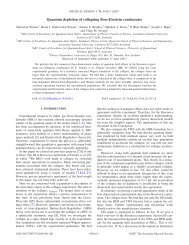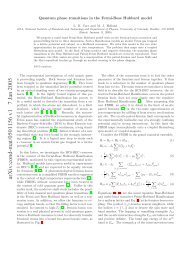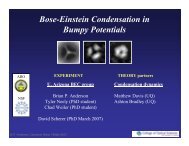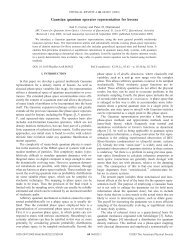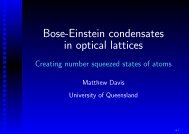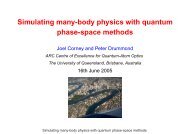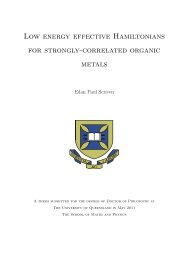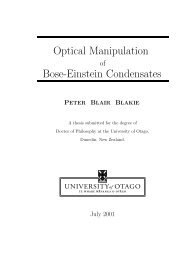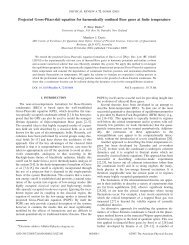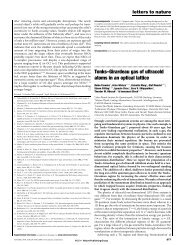Open Quantum Dynamics of Mesoscopic Bose-Einstein ... - Physics
Open Quantum Dynamics of Mesoscopic Bose-Einstein ... - Physics
Open Quantum Dynamics of Mesoscopic Bose-Einstein ... - Physics
Create successful ePaper yourself
Turn your PDF publications into a flip-book with our unique Google optimized e-Paper software.
7. <strong>Quantum</strong> simulations <strong>of</strong> evaporatively cooled <strong>Bose</strong> condensateswritten in terms <strong>of</strong> the Jacobi polynomials P n(α,β)√2(n +1)(R n (r) =P n(1,0) 1 − 2r )r max r max= (−1) n √2(n +1)r maxl=0las:n∑ ( n +1 )( nn − l) ( )r n−l ( ) 2r− 1 (7.21)r max r maxand the spherical harmonics reduce to[108]Y j (θ) =1√2πe iθj . (7.22)The angular momentum distribution is then given by a summation over the radial modes:〈 〉 ∑ 〈 〉n(j) = ˆΨ† jnˆΨ jn ′ = ∑n,n ′ n〈ˆΨ† ˆΨ〉jn jn + ∑ 〈ˆΨ† ˆΨ〉jn jn ′ . (7.23)n≠n ′In the simulations, we shall neglect the <strong>of</strong>f-diagonal coherences and calculate only the firstterm in Eq. (7.23). The angular momentum distribution for individual trajectories showslarge occupation in particular angular modes, different for each run. This indicates thatvortices with different momenta appear each time. For example, in the trajectory shownin Fig. 7.5, a vortex with j = −1 appears at about one quarter <strong>of</strong> the way through thesimulation, and persists until the end. A less stable vortex with j = −6 also forms, but thisdecays near the end <strong>of</strong> the simulation. The maximum occupation <strong>of</strong> the j = −1 vortexisaround n(j) = 20, owing to relatively small initial atom numbers in this two-dimensionaltrap simulation. The ensemble average <strong>of</strong> the angular momentum distribution, shown inFig. 7.6, reveals quite a broad range <strong>of</strong> final angular momentum; this is consistent withthe existence <strong>of</strong> vortices.7.5.4 Other trap geometries and cooling schemesAll the simulations hereto presented have used the sinusoidal potential and absorption,with the height <strong>of</strong> the potential swept downwards in time. We now consider some alternativeevaporation procedures.Figure 7.7 shows the evolution <strong>of</strong> a single three-dimensional trajectory using the trappr<strong>of</strong>iles V 3 and Γ 3 (defined in Eqs. (7.5c) and (7.6c), respectively), designed for the maximuminitial retention <strong>of</strong> atoms. This geometry is effective in that in the first few timesteps shown in the figure, up to three times more atoms are retained. This has the advantage<strong>of</strong> increasing the rate <strong>of</strong> the thermalising collisions, and should therefore aid the161



